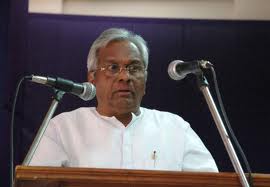Nilesh Kumar
“Wisdom is born in pain, suppression and insult. Experiences lead to the creation of best works” Kannada poet Mudnakudu Chinnaswamy said in a speech at Akhila Bharatha Kannada Sahitya Sammelana in Madikeri, early this year.
Director/writer Nagraj Manjule too, in his debut feature film ‘Fandry’ (pig in Kaikadi language), with his indelible mark, unwraps layers of discrimination, humiliation, Dalit aspirations, poor access to education and the stigma of being born in an ‘untouchable caste’. How does a dark Dalit aesthetic body become a weapon for reduction of the Dalit self from others as well as from itself?
He brings out the contempt in the minds of the upper caste kids, who mind sharing a school bench with a Dalit child in school. Sometimes, Dalit kids, too impose an exile on themselves. They feel insecure sharing a bench with the upper caste children. The sense of belonging is felt in sharing space with persons you can identify with, with persons from similar location, perhaps from the same caste.
‘Fandry’ is a very sincere effort in bringing out the everyday life of humiliation that a Dalit faces, through some dark humour attached to it. It is a story that any child of Jabya’s (the young protogonist) age and location in any village could experience. It highlights metaphorically ‘school’ as a ‘state’ where one can learn the ideas of social justice, empowerment, liberty, equality. But a place ideal for civic learning can also harbour a deep sense of caste-hatred. It can become a fulcrum for caste oppression, humiliation and reduction of the ‘Dalit self’. Move away from the film, and one will experience these contradictions in every walk of life. As Dr. Babasaheb Ambedkar had rightly said, “We are entering into the era of contradictions….”

In this notorious space (school), which in a conventional set- up only accepts Gandhi and Tilak as agents of change, Manjule consciously builds his own world, juxtaposing school and Dalit houses with the images of Babasaheb Ambedkar, Savtribai Phule, Jyotiba Phule, Shahu Maharaj, Anna Bhau Sathe and Sant Gadge Baba. It’s a tight slap on the faces of those who want to believe that we have grown up into a “mature” society. Those frames remind us through the film how we have restricted our great thinkers and reformers just to frames and portraits.
So, what is ‘Fandry’?
Since I first heard this word, I have been curious. Today, after having watched the film, I am still trying to decode the meaning. I do not want to restrict the work to its literal meaning. As Manjule, the director/writer of ‘Fandry’ said in one of his interviews, “How would you not know what is Fandry? Fandry is a very local Maharashtrian word. And, the truth is, we don’t know what Fandry is! It’s a story of our neighbourhood and we still don’t know it. That is precisely why I want to raise this question, how do you not know about ‘Fandry? If you aren’t aware about the name then it’s an invitation for you to watch it.
It is the life of people around you. It is about their happiness and sorrow. It is my story. It is the story of my friends. It is the story of my family. It is the story of many people like me.”
Manjule has used the term ‘Fandry’ metaphorically to depict ‘impurity’ that invariably gets associated with a Dalit body and his labour. So, when a fandry strays around and accidentally grazes an upper caste being, that person has to be purified. No less than by sprinkling “Gomutra” (cow urine). Expect such an illogical act- of one sprinkling an animal waste as process of (suddhikaran) purification necessitated by the touch of another animal! Only because pigs grow up on garbage (not all) and there are many castes/tribes who eat pig meat. (Pig eaters’ dignity isn’t rated too highly ~ Nagraj Manjule in an interview). Dominant castes have always tried to separate themselves from “others” through several instruments like rituals, power and status. If any Dalit body or their labour tries to transgress then he/she is ritually purified as shown in the scene.

Manjule brings out caste politics with a peek into the jatra (village fair). In one of the scenes Jabya’s father Kachru (meaning garbage, literally) stands outside the panchayat office listening to the upper caste men and the panchayat discuss the on-goings of a fair. He is allowed inside only to distribute tea.
The deep ingrained sense of discrimination is thrown right in your face. Even in a supposed democratic space like a Panchayat office, the decision making body constituted in the village, the lower caste individual is clearly expelled and prevented from assimilation with others. A caste society ties an untouchable down and limits him to the outer boundary of any dwelling. He is only looked at as a source of cheap labour. Unless and until equality is not foregrounded in the public spaces, how can one aspire to have a relationship or bonding with other castes? But, if the Dalit is given a position that has any semblance of equality, where will one find a Kachru to serve tea or to carry out any menial work?
At the time of the procession, Jabya lets his hair loose and dances. A village maverick- his friend (the character played by Manjule, himself), tells him to beat the drums like no one has ever done. As Jabya begins to forget himself, and begins to celebrate, he is elbowed and pushed by the upper caste village boys. He and his friend Piraji, slightly hassled, still continue to enjoy the moment. But they are reminded that the space does not belong to them. Adamant, Jabya still continues to dance, trying to grab his love’s (his class mate and an upper caste girl Shalu’s) attention. But at that moment, Jabya’s father pulls him out and makes him stand with a lantern on his head. Others continue to dance and Jabya stands there as a pole, with a lantern lodged on his head. Jabya’s suffocation, anger at being born as a Dalit, the humiliation he faces in front of his peers and his love, leaves the audience devastated. Even tears trickle down from Jabya’s eyes. A Dalit household is not a typical site of love and care. This space is also highly gendered and graded with power and inequality, from within. This is observed, time and again when Jabya’s family asks him to help them in menial work in the village and ignore his studies. His parents seduce him with a dream of new pair of clothes, just to get him to work with them.
Jabya’s father is seen struggling for his livelihood also and for his daughter’s marriage. The going gets tough, but he still does not want to return to the age-old caste based filthy, inhuman, laborious occupation of catching stray pigs. But, circumstances force him to do it… Amidst the jatra celebrations, as the chariot with images of god and goddesses lumbers around the village, a pig dashes the chariot- carrying men. Hell breaks loose as according to their beliefs this act is seen as a bad omen for the village.
Now, as Kachru has grown old, and his bones have turned brittle, it is the “duty” of the next generation- the two daughters and Jabya – to help him catch pigs in the village. And this is reinforced by the village Sarpanch, who insists that Kachru and his family will ensure the village is pig nuisance-free. Kachru, who had long given up the work, is now forced to return to catching pigs. Here, he is penalised not just for shying away from his “duty”. It is the “duty” of his next generation too – the two daughters and Jabya – to help him catch pigs in the village. Kachru too, desperate to raise money for the marriage of one of his daughters, silently takes up the delegated work. He is in return paid Rs. 2,000.
A caste-bound labour like this is sadly not carried out within four walls. It is out in the open, in complete public glare. And the villagers see this as an opportunity for amusement. Jabya is forced to stay back and help his family in capturing the stray swine of the village. His family suddenly becomes a source of entertainment for everyone. Alas, for Shalu, too. Boys from the dominant caste, Jabya’s classmates, all gather to watch him and his family ridiculously run behind pigs with a noose in hand. As the village boys continue to hoot and mock at Jabya and his family and take a dig at his “low being”, Shalu stands there at a corner giggling with her friend at Jabya’s acrobatics – oblivious of Jabya’s love for her- amused and entertained. The chase scene takes you to the dirty backyard of the village, where perhaps, only Jabya’s family is sanctioned to work. Jabya, desperate, runs away and hides every now and then (to save himself from the public laughter, shame, dishonour and humiliation from his schoolmates from other castes but especially from his love Shalu. He seeks help. But, is met with blows on his face from his father for shirking work.
In the midst of the chase, while the whole village mocks at Jabya, Manjule lampoons the idea of nationalism. He has effectively crafted a scene where just at the point when Jabya is about to capture a pig, the school in the backdrop breaks into the national anthem. Everyone including Jabya’s father is forced to stand straight and exhibit national pride. The look on his face, the anger and desperation is not missed.
Sadly, the burden of nationalism is always thrust on the depressed class. And if one refuses to subscribe to it, he is labelled as anti-national.
Why should one watch ‘Fandry’?
The best thing about ‘Fandry’….. Actually there is no one such thing that can be pointed out to be the best. It’s a complete package of perfection and genuineness. It is an honest attempt to tell his (Nagraj Manjule’s) Dalit story.
The biggest experiment that Manjule indulged in is Fandry’s cast. The lead role of Jabya aka Jambuvant is played by a young boy Somnath Awagade, who belongs to the ‘mang’ caste also considered impure and assigned lowly labour like beating Halgi (local drums) during village functions and celebrations. Awagade, too, in real life plays Halgi with his father and uncles. It is during one such village celebration, where Manjule was felicitated for his first short film Pistulia, that Awagade was spotted. It was Manjule’s concious decision to choose a non-actor for his debut feature film.

Jabya: Jabya or Jambwant is a Kaikadi untouchable, an aesthetically dark-skinned teenager… chasing his dreams, aspirations of loving and being loved by someone beautiful. He falls in love with an upper caste class mate Shalu. Through the film, Jabya is seen struggling with his own inhibitions, his own inferiority complexes. He is dark; school boys call him ‘Kaalya’.
His inhibition is only worsened by his failed family. His disturbed sister, a divorced sister, and a drunken father, add to his misery. While his peers continue to live a carefree life, Jabya is engulfed with stress. He has to take up menial jobs like selling pepsicola in a nearby village for that one pair of new clothes.
Kachru proudly names his son Jambavant, after the great King Jambavant, whose account can be seen in many historical and anthropological texts. Madiga (a Dalit sub caste) legends of origin connect to King Jambavant. Historians claim Jambavant was a Buddhist king. The king of Jambudwipa (Jambu denotes a Jambul tree or Indian Blackberry and dvipa means ‘island’ or ‘continent’). It is also an ancient Buddhist name for the Indian sub-continent, representing an egalitarian society, where every sentient being was enlightened. Where every human being was to receive Dhamma- the four noble truths along with the noble eightfold path, breaking the cycle of life and death.
Another account of Jambavant can be seen in T R Singh’s (The Madiga of Telangana, 1969), where he as a king of Jambudvipa owns a divine cow, which no other king of the day was privileged to own. The cow possessed a unique power to grant any wishes of the owner, if he prayed to her. A neighbouring king was visiting Jambavant. To extend his hospitality to the royal guest, Jambavant prayed to the divine cow to fulfil the wishes of the visitor. The king, impressed by the powers of the divine cow, requested Jambavant to give away the cow to him. But Jambavant declined. The king feeling insulted, ordered his men to capture the cow. The king’s men attacked the palace and in the battle, he was defeated.
The defeated king once again attacked Jambavant’s palace, but this time the divine cow cursed him, and he was burnt to ashes. The king’s son was enraged and decided to take revenge. Dressed as a poor man, he entered the palace in Jambavant’s absence and induced the latter’s son to kill the cow so that he could feast on its flesh. On knowing this Jambavant took the offenders to the court of Siva for judgment. Fearing the wrath of Siva the two offenders did not enter the court: they stood outside by the two sides of the doorway. Siva cursed them to become Chandal or Untouchable. The one who stood on the right hand side of the doorway became the ancestor of the Mala caste, while the one who was on the left became the ancestor of the Madiga”.
Manjule intersperses the imagery of the King and his divine cow with Jabya and a black tailed sparrow. An analogy can be drawn from legend of the king of Jambudvipa, Jambavant, to the king of Begampura (an ideal place, land without sorrow as conceived by Sant Ravidass).
Begampura sahar ko naon
Dookh andoh nahin the thaon
Na tasvis khiraj na maal.
Khauf na khata na taras jawal.
Ab mohi khoob watan geh payee.
Oohan khai sada merai bhai.
(An ideal place, the domain, in which there is no worry, there is no pain, there is no anxiety. There is no fear of revenue or taxation recovery. There is no need to fear anything or to feel guilty or to pray for compassion or a decline (of values). I have found such a nice place where all is well, my brother.).
In Majule’s Fandry Jabya seeks an ideal world like Begampura. He strives to change his life. He seeks social and cultural mobility and a discrimination-free life. He forgets the caste division when he falls in love with an upper caste girl. He forgets he is an untouchable Dalit being and she an unattainable upper caste beauty. His love for her, at least during his dreams in Jambudvipa, becomes sacred, pure and pristine. It gives him power to retaliate, resist and rebel against his family and the system which prevents his platonic love from growing. The legend of the black-tailed sparrow compels him to look for it so that it would fulfill his wishes, just like Jambavant King’s divine cow.

Jabya, like the king is fearless. He does not resort to violence as a means to confront the dominant caste abuses and humiliation. But at this point the commonalities end. Unlike the King who found a place where all is well, in Jabya’s world, it is not all well, after all. At the end, when he is confronted by the dominant caste pervert, who abuses his sister with sexual innuendoes, Jabya picks up a stone and throws it right at the camera. A stone fills the screen and hits each face watching the film… each of us, who don’t know the existence of ‘Fandry’, who refuse to acknowledge ‘Fandry’. It finally challenges the system’s (caste) supremacy.
I would like to thank Sukanya for structuring my thoughts.
[Please watch the official trailer of the movie Fandry here]
~
References
Kaur, D. (2009, April 1). Sri Guru Granth Sahib: The sublime legacy : Vol 2. Retrieved 2014, from VismaadNaad.org: http://www.vismaadnaad.org/divinity.php
Burnouf, E. (2010). Introduction to the History of Indian Buddhism, Chicago: The University of Chicago Press.
ed. Guru, G. (2011). Humiliation claims and context, New Delhi: Oxford University Press.
Rajpramukh, K. E. (2013). Satellite Castes and Dependent Relations: Dalits in South India, New Delhi: Partride India Penguin Books India Pvt. Ltd.
~~~
Nilesh Kumar is a Ph.D researcher in Tata Institute of Social Sciences, Mumbai, and his main interest is to document the narratives and experiences of discrimination which Dalit students face while pursuing Higher Education.
[Pictures courtesy: the net]









